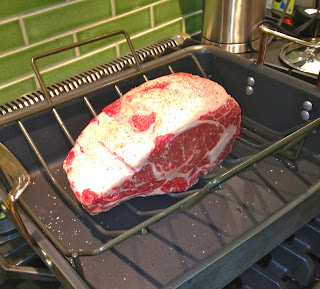We're just back from a trip to Belgium and northern France. We ate and drank well, of course. It was cold and wet, of course.
And, of course, we had a great time. But we also spent some time contemplating the Great War. We visited the battlefields of the Somme where between July 1 and November 18, 1916 more than 1.1 million soldiers were wounded or killed. The British had more than 57,000 casualties on the first day of the battle alone. The distances gained and lost between the French and British on one side and the Germans on the other are such that one could walk them at a leisurely pace between breakfast and lunch.
We also toured the area where my grandfather fought as an infantryman during the summer and fall of 1918 as part of the 119th Infantry, 30th U.S. Division. The regiment was assigned to II U.S. Corps, and further to the Fourth Army under British General Rawlins. They were, in effect, borrowed soldiers (the title of
Mitch Yockleson's book about the U.S. troops.). My grandfather was a draftee from the mountains of western North Carolina. He had never been out of the state, except maybe just across the border into Tennessee or South Carolina, before the war.
I knew my grandfather only reasonably well. He never travelled to our house in Virginia Beach from his home in Hendersonville. And although we travelled to see him many summers, I don't remember spending long hours with him listening to stories. I wish I had.
I do remember hearing him tell about how he was wounded. He said he was on a small patrol ahead of the established U.S. lines and came under fire. I don't remember if he said all or most of the others on the patrol were killed. He said with a laugh that he ran three Germans to death--he was in front of them. He was wounded, shot in the heel, and said he was so cold and so scared that he didn't even really know he had been shot until he reached his own lines. That happened, according to
a history of his unit, on October 10th, 1918; about a month before the Armistice and only a week after the regiment had crossed
the St Quentin canal, a significant obstacle and part of the Hindenburg Line.
This map is part of the Somme Bellicourt Memorial to the U.S. 27th and 30th Divisions. You can see the position of the Riqueval Bridge (over the St Quentin Canal), centered in the 30th Division sector.
The Riqueval Bridge was captured by a unit of the 6th North Staffordshire Regiment, an English infantry regiment. But it appears to be in the center of the U.S. 30th Division sector. I suppose that shows how inter-twined the units were, and how chaotic things must have been amid the smoke, fog, and shelling: a British company commander told historians that he led his company across the bridge
"having accidentally discovering it was intact after getting lost."
This is the Riqueval Bridge on October 2, 1918, three days after it was captured. Brigadier John Campbell, VC is addressing his regiment.
Here's the bridge today. Not much has changed.
My grandfather's division was relieved by the Fifth Australian Division the following day and spent a few days in reserve, resting and refitting before returning to the line on October 5 and fighting through the evening of the 10th. The wound card I've seen for him said he was shot near the town of Premont, but the maps of action shows the regiment considerably further east-north-east on 10/10. Premont was likely the divisional headquarters or the rear area hospital where he was taken.
Premont itself is a small town, with one main road and a single church. There is farmland and rolling hills all around. It is really quite a lovely place. The picture above is on a small dirt and gravel road just entering the town from the west.
The Catholic church in Premont with a memorial to the fallen of the Great War.
The main road through town is named Rue du General Tyson, after the commander of the 59th Regiment -- the other regiment in my grandfather's brigade.
Regardless, of precisely where he was when he was wounded, October 10th was the end of his fighting in the war. He left the front as a private first class and was awarded the Purple Heart Medal. At some point during his recovery or during demobilization, he was promoted corporal.
Once he got home in 1919, I don't think he left town again, at least not for long. And while I'm glad I had the chance to see the area he fought through, I wish I had been able to do so with him.
Gravestone, Berea Baptist Church Cemetery (aka Capps Cemetery), Flat Rock, N.C.

















































